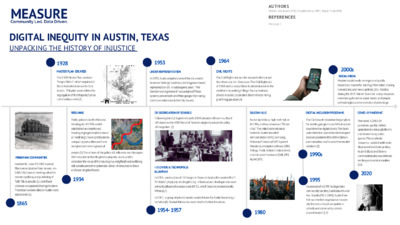2a.3 - MEASURE Timeline COA RTS - Historical Timeline — original pdf
Backup

AUTHORS Urenna Onyewuchi, PhD, Paulette Blanc, MPH, Reyda Taylor,PhD REFERENCES See page 2 REDLINING DE-SEGREGATION OF SCHOOLS SILICON HILLS DIGITIAL INCLUSION PROGRAMS COVID-19 PANDEMIC DIGITAL INEQUITY IN AUSTIN, TEXAS UNPACKING THE HISTORY OF INJUSTICE 1928 MASTER PLAN CREATED The 1928 Master Plan created a "Negro District" which required all Black Austinites to move to East Austin. This plan evolved into the segregation of the Hispanic/Latino community as well (2). Public policies like the National Housing Act of 1934, which established and reinforced housing segregation (also known as "redlining"), have contributed to unequal opportunities and have marginalized certain groups of people (3). The echoes of this policy still influence our cityscapes. With educational funding tied to property. taxes, and in extension the value of the housing in a neighborhood, redlining still contributes to the systematic denial of resources to Black and poor neighborhoods. 1934 FREEDMAN COMMUNITIES Juneteenth, June 19, 1865 marked Black emancipation from slavery. An 1865 City Council meeting called for extreme policing and punishing of “idle” Black people (1).; anti-Black violence was praised. During this time Freedman communities in Austin were established (1). 1865 2000s SOCIAL MEDIA Modern social media emerges and quickly becomes a means for sharing information, making connections, and news updates. (11). Notably during the 2021 Winter Storm Uri many resources were being shared via social media and people without digital access were at a disadvantage. 1953 UNDER-REPRESENTATION 1964 CIVIL RIGHTS In 1953, Austin adopted a model for city council based on "at large" positions, limiting place-based representation (4). In subsequent years "The Gentlemen's Agreement" was adopted. These systems prevented non-White groups from being able to win elections to the City Council. The Civil Rights Act was the second to the last act that threw out Jim Crow laws. The Civil Rights Act of 1964 dealt a crucial blow to discrimination in the workforce by making it illegal for any business, private or public, to practice discriminatory hiring (and firing) practices (9). Following the U.S. Supreme Court’s 1954 decision in Brown vs. Board of Education, the AISD Board of Trustees originally adopted a policy of integration (5). Austin started as a high-tech hub in the '80s, and was known as “Silicon Hills.” The initial tech industries hosted in Austin included semiconductor (AMD, Samsung, Motorola/Freescale/NXP, Applied Materials), enterprise software (IBM, Trilogy, Tivoli, National Instruments) and computer hardware (Dell, IBM, Apple) (10). The Clinton administration began plans for creating programs and infrastructure to address the digital divide. The Bush administration succeed and developed policies counter to that of the Clinton administration and favored free-market solutions (8). 1990s The novel COVID-19 pandemic quickly shifted operations to virtual platforms and closed many public spaces. The pandemic became a public health crisis disproportionately impacting Austin's Black and Brown communities also exacerbates existing economic inequities (12). 2020 I-35 DIVIDE & TECHNOPOLIS BLUEPRINT In 1954, construction of I-35 began in Texas. In Austin, this created the "I- 35 divide", physically dividing the city. Infrastructural developments were primarily allocated to areas west of I-35, which became predominantly White (6,7). In 1957, a group of private leaders created vision for Austin becoming a tech hub (8). Several think tanks were held to further this vision. 1954- 1957 1980 1995 Incorporated in 1995 by legendary community leaders, Sue Beckwith and Ana Sisnett (1952-2009), Austin Free- Net was the first organization to wire city libraries and put computers in schools and community centers around Austin.” (13) REFERENCES 1. Foster, K.M. (2019). Destruction of Black Communities in the Name of Progress – The Case of Austin, 1865-1928, (Report No. 1). Institute for Urban Policy Research & Analysis, College of Liberal Arts, The University of Texas at Austin. 2. Koch and Fowler Consulting Engineers. "A City Plan for Austin, Texas 1928" pg. 57; Available online via Central Austin CDC Link: https://centralaustincdc.org/diversity/cityofaustinplan_1928.pdf 3. Little, B. (2020, October 20). How a new deal housing program enforced segregation. Retrieved May 07, 2021, from https://www.history.com/news/housing-segregation-new-deal-program 4. The “Gentleman’s Agreement “- A Relic of Austin’s Racist Past: Or, Why Did We Need to Change the system, anyway?.” ( 2014) Retrieved from http://www.oraatx.com/blog/2014/8/19/the-gentlemens-agreement-a-relic-of-austins-racist-past-or-why-did-we-need-to-change-the-system-anyway 5. Straubhaar, J. D., Spence, J., Tufekci, Z., Lentz, R. G., Straubhaar, J., Tufekci, Z., Spence, J., & Rojas, V. (2013). Structuring Race in the Cultural Geography of Austin. In Inequity in the Technopolis race, class, gender, and the digital divide in Austin (pp. 60–61). essay, University of Texas Press. Straubhaar, J. D., Spence, J., Tufekci, Z., & Lentz, R. G. (2013). Inequity in the Technopolis race, class, gender, and the digital divide in Austin. University of Texas Press. 6. Texas State Library and Archives Commission. (n.d.). From pioneer paths to superhighways - the texas highway department blazes texas trails 1917-1968. The Great Age of Building, Texas Highway Department - Page 2 | TSLAC. Retrieved January 30, 2022, from https://www.tsl.texas.gov/exhibits/highways/greatage/page2.html 7. Zehr, D. (n.d.). Inheriting inequality: Austin's segregation and gentrification. Austin American-Statesman. Retrieved January 30, 2022, from https://projects.statesman.com/news/economic-mobility/ 8. Straubhaar, J. D., Spence, J., Tufekci, Z., & Lentz, R. G. (2013). Inequity in the Technopolis race, class, gender, and the digital divide in Austin. University of Texas Press. 9. Office of the Assistant Secretary for Administration & Management. (n.d.). Legal highlight: The civil rights act of 1964. United States Department of Labor. Retrieved January 30, 2022, from https://www.dol.gov/agencies/oasam/civil-rights-center/statutes/civil-rights-act-of-1964 10. Silicon Hills reference 11. Dijck José van. (2013). Engineering Sociality in a Culture of Connectivity. In The culture of connectivity: A critical history of social media (pp. 3–9). essay, Oxford University Press. 12. Knight, A. D. (2021, April 12). UT report finds disparities in COVID-19 vaccine and infection rate between East and West Austin. KVUE-TV. Retrieved January 30, 2022, from https://www.kvue.com/article/news/local/ut-report-finds-disparity-between-east-and-west-austin-vaccine-distribution/269-6893195c-be27-47be- a70c-544ad4108ff9 13. Austin Free Net - https://www.austinfree.net/about Retrieved: 1/31/2022